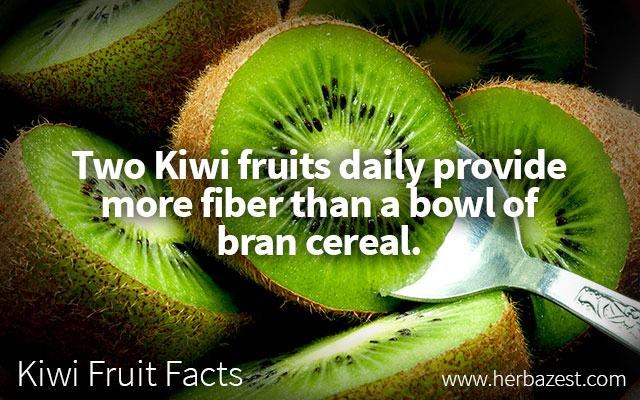Did you know that kiwi plants can grow as tall as 65 feet (20 m)? Or that not only is the skin of kiwi edible, but it also increases the daily fiber intake? There is a lot to learn about this exotic and delicious fruit. The following are some interesting kiwi fruit facts:
Among many kiwi fun facts, this is the most intriguing, and at times confusing: the popular name of this fruit was first given in New Zealand in 1959, after the country's national animal (the kiwi bird), due to the resemblance between the fruit's hairy skin and the brown feathers of the kiwi bird.
The kiwi fruit still goes by many different names in its home country, China, where some popular monikers for it are: monkey peach, macaque pear, vine pear, sun peach, and wood berry.
Kiwi scientific name is Actinidia deliciosa and, botanically speaking, it is classified as a berry fruit because of its 1,400 seeds and the fact that it is formed through the pollination of a climbing vine plant.
When it comes to kiwi vitamins, the seeds are higher in vitamin C than the core and skin, while kiwi's vitamin E is concentrated in the flesh of the fruit.
There are only 61 calories in kiwi per 100 grams as well as 92.7 milligrams of vitamin C, slightly exceeding the average daily requirement for adults (90 mg for men, 75 mg for women).
Many studies have shown that the especially high vitamin C content in kiwi helps support immunity and alleviate the effects of stress and aging.
The fiber in kiwi is particularly high; two fruits provide more than a bowl of bran cereal and help improve digestion.
Kiwi is fat free and rich in antioxidants, which help reduce the risk of cancer, heart disease, and stroke.
Kiwi nutrition can be best reaped in the raw form of the fruit. A popular method of doing this is to sloop it, by cutting the fruit in half and scooping the flesh out of the skin.
'Hayward' is by far the most popular and nutritious kiwi cultivar, and it is produced in New Zealand, California, Chile, and Italy.
When choosing a raw kiwi fruit, size does not impact flavor, but the firmness of the fruit will tell you whether it is ready to eat. If a fruit is ripe, it will give to slight pressure when pressed.
Kiwi should not be consumed with dairy products, since it contains and enzyme called actinidain, which breaks down the proteins in milk, leaving a bitter taste. However, the same compound makes a great meat tenderizer.
While this small berry fruit is generally consumed raw, in a wide variety of healthy kiwi recipes, it can also be cooked, and consumed in the form of jams and pies, among other culinary creations.
Chinese khans (rulers) used to believe that the kiwi fruit was an aphrodisiac.
Kiwi benefits go beyond the fruit. The vines, roots, and branches of the kiwi plant have been used traditionally as a fever reducer, diuretic, and a sedative.
The main pollinator in kiwi plant reproduction is the honeybee.
One unique use of the kiwi plant is the Chinese practice of using its branches and leaves to treat a skin disease in dogs called mange (demodicosis).
In China, the stems of the kiwi vines are used as rope. Kiwi leaves and bark are used to make paper, and if the bark is removed from the base of the vine and placed in hot ashes, it can be used as a pencil.
The kiwi fruit is native to Asia, and today's biggest producer is China, which harvested and estimated of 1,840,000 tons in 2014, followed by Italy and New Zealand.
While North America has become a big producer of kiwi, the only state that cultivates the fruit in commercial scale is California.
These are some interesting facts about kiwis that make these small, flavorful berries even more attractive as a cultural and culinary phenomena across the world.
Sources
- California Rare Fruit Growers, Kiwifruit Actinidia deliciosa
- Kiwifruit: Actinidia deliciosa
- National Institutes of Health, Vitamin C
- Purdue University, NewCROP: Kiwifruit: Actinidia deliciosa
- Te Ara - The Encyclopedia of New Zealand, Story: Kiwifruit
- United States Department of Agriculture, Foreign Agricultural Services, New Zealand, Kiwifruit Sector Report - 2016
- USDA Nutrient Database, Kiwifruit, green, raw




